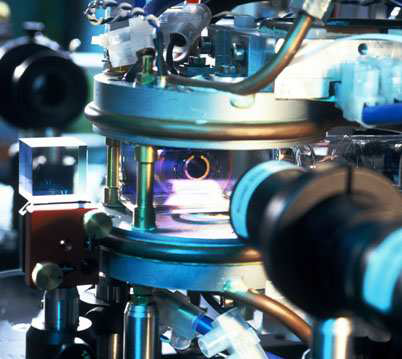Overview Rubidium cavity setup
The experimental chamber mainly consists of five different components:
- Magneto-optical trap (MOT) with Rubidium atoms
- Magnetic transport to Science Chamber
- 3D optical lattice
- Magnetic coils for controlling Feshbach resonance
- High-Q Optical Cavity

MOT chamber
We use a magneto-optical trap to trap and cool Rb-87 or Rb-85 atoms from the background gas. This sequence typically takes a few seconds and the atoms are subsequently further cooled down in the MOT chamber using optical molasses, reaching temperatures of about 100 micro K. After this, the atoms are optically pumped into the state F = 1, mF = 1 and transferred into a magnetic trap.


Magnetic transport
We transport the cold atoms from the MOT chamber to the Science Chamber with the help of a magnetic transfer line in about 1.5 seconds. This transfer line produces a moving magnetic trap. It consists of 13 different coils which are switched on an off in sequential fashion. The picture on the left shows the transfer line at an early stage of the set up.
Previous Science Chamber: Glass cell
In our previous setup the Science Chamber consisted of a glass cell with an optical lattice and a magnetic quadrupole Ioffe configuration (QUIC) trap. Using radio-frequency evaporative cooling it was possible to produce Bose-Einstein-Condensates (BEC) of Rb atoms. Furthermore, by switching the QUIC coils into Helmholtz configuration it was possible to create Feshbach molecules.


The new Science Chamber
Besides an optical lattice and tunable magnetic fields, the new Science Chamber will additionally provide a high-q optical cavity, a channeltron and a high NA lens. In order to move atoms and molecules in and out of the optical cavity an optical dipole trap can shift the particles over a 5mm distance. The channeltron can be used to detect ions after state-selective ionization of Rb atoms or Rb2 molecules. To observe atoms or molecules inside the Science chamber a high NA lens collects their fluorescence light. A special vibration isolation stage protects the cavity agains acoustic noise, so that the cavity can be actively stabilized to specific wavelengths.


Cavity design
We use a free space cavity for maximal optical access of the particles inside the cavity and the science chamber. The cavity mirrors are combined with grin lenses so that we can conveniently work with collimated laser beams going in and coming out of the optical cavity. Furthermore, the free space setup allows for shaping the mode profile of the cavity.
